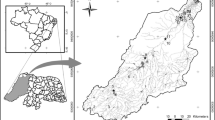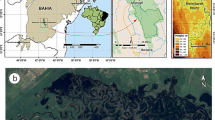Abstract
The “Pantanal” wetland is one of the largest centers of diversity of aquatic macrophytes of Brazil. The objective of this work was to present a checklist of aquatic macrophytes, and to investigate structure and patterns of occurrence regarding physico-chemical parameters, at Amolar, in the Paraguay River sub-region, in the mid-western “Pantanal” wetland, Corumbá (MS). No previous aquatic plant study has been carried out there so far. The study was conducted in June 2009 in 391 plots (0.5 × 0.5 m). We recorded 65 species of aquatic macrophytes, from 49 genera and 27 families. The richest families were Fabaceae, Poaceae, Convolvulaceae, Onagraceae, and Lentibulariaceae. The most representative life forms were emergent and free floating, comprising the most frequent species: Hymenachne amplexicaulis (Rudge) Nees, Salvinia auriculata Aubl., Ricciocarpos natans (L.) Corda, Lemna aequinoctialis Welw. and Azolla filiculoides Lam. presented the highest relative cover, as well as the highest importance value, followed by S. auriculata. The structure of the community of aquatic macrophytes presents relation with physico-chemical variables, chiefly depth: many species occurred exclusively in shallow areas and others in deep zones. The life forms partially explain the species zonation of macrophytes in relation to depth.





Similar content being viewed by others
References
Agostinho AA, Gomes LC, Pelicice FM (2007) Ecologia e manejo de recursos pesqueiros em reservatórios do Brasil. Eduem, Maringá
Anderson R, Kalff J (1988) Submerged aquatic macrophytes biomass in relation to sediment characteristics in ten temperate lakes. Freshw Biol 19:115–121
Apg III (2009) An update of the angiosperm phylogeny group classification for the orders and families of flowering plants: APG III. Bot J Linn Soc 161:105–121
Barko JW, Adams MS, Clesceri NL (1986) Environmental factors and their consideration in the management of submersed aquatic vegetation—a review. J Aquat Plant Manag 24:1–10
Bornette G, Puijalon S (2011) Response of aquatic plants to abiotic factors: a review. Aquat Sci 73:1–14. doi:10.1007/s00027-010-0162-7
Bryson CT, Maddox VL, Carter R (2008) Spread of Cuban Club-Rush (Oxycaryum cubense) in the Southeastern United States. Invasive Plant Sci Manag 1:326–329. doi:10.1614/IPSM-08-083.1
Burnham KP, Anderson DR (2002) Model selection and multimodel inference: a practical information theoretic approach, 2nd edn. Springer, New York
Casatti L, Mendes HF, Ferreira KM (2003) Aquatic macrophytes as feeding site for small fishes in the Rosana Reservoir, Paranapanema River, southeastern Brazil. Braz J Biol 63:213–222
Castro CRT, Garcia R (1996) Competição entre plantas com ênfase no recurso luz. Ciênc Rural 26(1):167–174. doi:10.1590/S0103-84781996000100031
Catian G, Leme FM, Francener A, Carvalho FS, Galletti VS, Pott A, Pott VJ, Scremin Dias E, Damasceno Junior GA (2012) Macrophyte structure in lotic-lentic habitats from Brazilian Pantanal. Oecol Aust 16:782–796. doi:10.4257/oeco.2012.1604.05
Colwell RK (2009) EstimateS, Version 8.2: statistical estimation of species richness and shared species from samples (Software and User’s Guide). Freeware for Windows and Mac OS. http://viceroy.eeb.uconn.edu/estimates. Accessed 12 Dec 2010
Cook CDK (1996) Aquatic and wetland plants of India. Oxford University Press, Oxford
Csurhes SM, Mackey AP, Fitzsimmons L (1999) Hymenachne (Hymenachne amplexicaulis) in Queensland. Pest status review series—land protection. Department of Natural Resources and Mines, Queensland
Cunha NL, Delatorre M, Rodrigues RB, Vidotto C, Gonçalves F, Scremin-Dias E, Damasceno-Junior GA, Pott VJ, Pott A (2012) Structure of aquatic vegetation of a large lake, western border of the Brazilian Pantanal. Braz J Biol 72(3):519–531. doi:10.1590/S1519-69842012000300015
Damasceno Junior GA, Pott A (2011) Métodos de amostragem em estudos fitossociológicos sugeridos para o Pantanal. In: Felfiti JM, Eisenlohr PV, Melo MMRF, Andrade LA, Meira-Neto JAA (eds) Fitossociologia no Brasil: Métodos e estudos de caso, vol 1. Editora UFV, Viçosa
Damasceno Júnior GA, Semir J, Santos FAM, Leitão-Filho HF (2004) Tree mortality in a riparian forest at Rio Paraguai, Pantanal, Brazil, after an extreme flooding. Acta Bot Bras 18:839–846. doi:10.1590/S0102-33062004000400014
Ferreira FA, Mormul RP, Thomaz SM, Pott A, Pott VJ (2011) Macrophytes in the upper Paraná river floodplain: checklist and comparison with other large South American wetlands. Rev Biol Trop 59:541–556
Forzza RB, Leitman PM, Costa AF, Carvalho AA Jr, Peixoto AL, Walter BMT, Bicudo C, Zappi D, Costa DP, Lleras E, Martinelli G, Lima HC, Prado J, Stehmann JR, Baumgratz JFA, Pirani JR, Sylvestre L, Maia LC, Lohmann LG, Queiroz LP, Silveira M, Coelho MN, Mamede MC, Bastos MNC, Morim MP, Barbosa MR, Menezes M, Hopkins M, Secco R, Cavalcanti TB, Souza VC (2010) Catálogo de Plantas e Fungos do Brasil. Instituto de Pesquisas Jardim Botânico do Rio de Janeiro/Andréa Jakobsson Estúdio, Rio de Janeiro
Gopal B, Sharma KP (1981) Water-hyacinth (Eichhornia crassipes), most troublesome weed of the world. Hindasia Publications, Delhi
Gross EM, Johnson RL, Hairston NG Jr (2001) Experimental evidence for changes in submersed macrophyte species composition caused by the herbivore Acentria ephemerella (Lepidoptera). Oecologia 127:105–114. doi:10.1007/s004420000568
INPE—Instituto Nacional de Pesquisas Espaciais (2009) Imagem do satélite LANDSAT 5, sensor TM, canais 1, 2, 3, 4, 5 e 7, órbita/ponto: 227/072 de 12/07/2009. São José dos Campos, São Paulo
Irgang BE, Pedralli G, Waechter JI (1984) Macrófitos aquáticos da Estação Ecológica do Taim, Rio Grande do Sul, Brasil. Roessleria 6:395–404
Johnson J, Omland K (2004) Model selection in ecology and evolution. Trends Ecol Evol 19:101–108
Junk, WJ, Piedade, MTF (1993) Biomass and primary production of herbaceous plants communities in the Amazon floodplain. Hydrobiologia 263:155–162
Lehmann A, Castella E, Lachavanne JB (1997) Morphological traits and spatial heterogeneity of aquatic plants along sediment and depth gradients, Lake Geneva, Switzerland. Aquat Bot 55:281–299
Madsen VD, Chambers PA, James WF, Koch EW, Westlake DF (2001) The interaction between water movement, sediment dynamics and submersed macrophytes. Hydrobiologia 444:71–84. doi:10.1023/A:1017520800568
Marion L, Paillisson JM (2002) A mass balance assessment of the contribution of floating-leaved macrophytes in nutrient stocks in an eutrophic macrophyte-dominated lake. Aquat Bot 75:249–260. doi:10.1016/s0304-3770(02)00177-8
Martín J, Luque-Larena JJ, López P (2005) Factors affecting escape behavior of Iberian green frogs (Rana perezi). Can J Zool 83:1189–1195. doi:10.1139/z05-114
Oksanen J, Blanchet FG, Friendly M, Kindt R, Legendre P, McGlinn D, Minchin PR, O’Hara RB, Simpson GL, Solymos P, Stevens MHH, Szoecs E, Wagner H (2016) Package ‘vegan’. https://cran.r-project.org/web/packages/vegan/vegan.pdf. Accessed 06 Aug 2016
Padial AA, Bini LM, Thomaz SM (2008) The study of aquatic macrophytes in Neotropics: a scientometrical view of the main trends and gaps. Braz J Biol 68:1051–1059. doi:10.1590/S1519-69842008000500012
Pedralli G (1992) Macrófitos aquáticos: centro de diversidade. Ciênc Hoje 14:56–57
Pedralli G, Irgang BE, Pereira CP (1985) Macrófitos aquáticos do Município de Rio Grande, Rio Grande do Sul, Brasil. Revista AGROS 20:45–52
Pelicice FM, Agostinho AA (2006) Feeding ecology of fishes associated with Egeria spp. patches in a tropical reservoir Brazil. Ecol Freshw Fish 15:10–19. doi:10.1111/j.1600-0633.2005.00121.x
Pereira AS, Trindade CRT, Albertoni EF, Palma-Silva C (2012) Aquatic macrophytes as indicators of water quality in subtropical shallow lakes Southern Brazil. Acta Limnol Bras 24:52–63
Pivari MO, Pott VJ, Pott A (2008) Macrófitas aquáticas de ilhas flutuantes (baceiros) nas sub-regiões do Abobral e Miranda, Pantanal, MS, Brasil. Acta Bot Bras 22:563–571. doi:10.1590/S0102-33062008000200023
Pott VJ, Pott A (2000) Plantas aquáticas do Pantanal. EMBRAPA, Corumbá
Pott VJ, Pott A (2003) Dinâmica da vegetação aquática do Pantanal. In: Thomaz SM, Bini LM (eds) Ecologia e manejo de macrófitas aquáticas. Editora da Universidade Estadual de Maringá, Maringá, pp 145–162
Pott VJ, Bueno NC, Pereira RAC, Salis SM, Viera NL (1989) Distribuição de macrófitas aquáticas numa lagoa na Fazenda Nhumirim, Nhecolândia, Pantanal, MS. Acta Bot Bras 3:153–168. doi:10.1590/S0102-33061989000300015
Pott VJ, Pott A, Lima LCP, Moreira SN, Oliveira AKM (2011) Aquatic macrophyte diversity of the Pantanal wetland and upper basin. Braz J Biol 71:255–263
Pott VJ, Ferreira FA, Arantes ACV, Pott A (2012) How many species of aquatic macrophytes are there in the Brazilian Pantanal wetland? An updated checklist. Anais do 1o Congresso Brasileiro de Áreas Úmidas (I CONBRAU), Cuiabá
Pressey RL, Adam P (1995) A review of wetland inventory and classification in Australia. Classification and Inventory of the World’s Wetlands, Advances in Vegetation Science, vol 16. Kluwer Academic Publishers, Dordrecht
Pulido C, Riera JL, Ballesteros E, Chappuis E, Gacia E (2015) Predicting aquatic macrophyte occurrence in soft-water oligotrophic lakes (Pyrenees mountain range). J Limnol 74:143–154. doi:10.4081/jlimnol.2014.965
R Development Core Team (2013) R: A language and environment for statistical computing. R Foundation for Statistical Computing, Vienna, Austria. http://www.R-project.org. Accessed 04 July 2014
Rocha CG, Resende UM, Lugnani JS (2007) Diversidade de macrófitas em Ambientes aquáticos do IPPAN na Fazenda Santa Emília, Aquidauana, MS. Rev Bras Biociênc 5:456–458
Schwarz AM, Hawes I (1997) Effects of changing water clarity on characean biomass and species composition in a large oligotrophic lake. Aquat Bot 56:169–181
Silva JSV, Abdon MM (1998) Delimitação do Pantanal brasileiro e suas sub-regiões. EMBRAPA 33:1703–1711
Silva RMM, Carniello MA (2007) Ocorrência de macrófitas em lagoas intermitentes e permanentes em Porto Limão, Cáceres-MT. Rev Bras Bioc 5:519–521
Soares MTS, Soriano BMA, Abreu UGP, Santos S.A (2010) Monitoramento do comportamento do Rio Paraguai na região de Corumbá, Pantanal Sul-Mato-Grossense, 2009–2010. Embrapa Pantanal Comunicado Técnico 85. http://www.cpap.embrapa.br/publicacoes/online/COT85.pdf. Accessed 10 Aug 2010
Soriano BMA (1997) Caracterização climática de Corumbá, MS Embrapa. Boletim de Pesquisa, Corumbá
Spence DHN, Maberly SC (1985) Occurrence and ecological importance of HCO3 use among aquatic higher plants. In: Lucas WJ, Berry JA (eds) Inorganic carbon uptake by aquatic photosynthetic organism. The American Society of Plant Physiologists, Maryland
Tanaka RH, Cardoso LR, Martins D, Marcondes DAS, Mustafá AL (2002) Ocorrência de plantas aquáticas nos reservatórios da Companhia Energética de São Paulo. Planta Daninha 20:101–111. doi:10.1590/S0100-83582002000400012
Thomaz SM, Cunha ER (2010) The role of macrophytes in habitat structuring in aquatic ecosystems: methods of measurement, causes and consequences on animal assemblages’ composition and biodiversity. Acta Limnol Bras 22:218–236
Vermaat JE, Santamaria L, Roos PJ (2000) Water flow across and sediment trapping in submerged macrophyte beds of contrasting growth form. Arch Hydrobiol 148:549–562
Vestergaard O, Sand-Jensen K (2000) Alkalinity and trophic state regulate aquatic plant distribution in Danish lakes. Aquat Bot 67:85–107. doi:10.1016/S0304-3770(00)00086-3
Acknowledgements
We thank the Graduate Programs of Plant Biology and of Ecology and Conservation for financial support, to ECOA for logistic support, to the Brazilian agencies for scholarships to C. Aoki (Conselho Nacional de Desenvolvimento Científico e Tecnológico - CNPq), R. M. Gamarra (Coordenação de Aperfeiçoamento de Pessoal de Nível Superior - CAPES), and to CAPES and CNPq for grants to A. Pott and E. Scremin-Dias.
Author information
Authors and Affiliations
Corresponding author
Rights and permissions
About this article
Cite this article
Aoki, C., Teixeira-Gamarra, M.C., Gamarra, R.M. et al. Abiotic factors drive the structure of aquatic plant assemblages in riverine habitats of the Brazilian “Pantanal”. Braz. J. Bot 40, 405–415 (2017). https://doi.org/10.1007/s40415-016-0345-0
Received:
Accepted:
Published:
Issue Date:
DOI: https://doi.org/10.1007/s40415-016-0345-0




